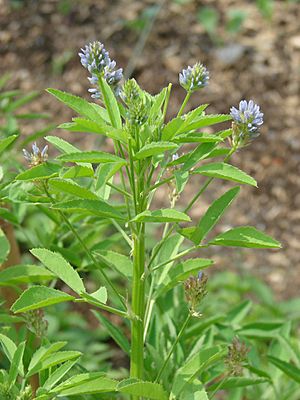Blue fenugreek facts for kids
Quick facts for kids Blue fenugreek |
|
|---|---|
 |
|
| Scientific classification |
Blue fenugreek (its scientific name is Trigonella caerulea) is a type of plant that lives for only one year. It belongs to the Fabaceae family, which includes peas and beans. This plant can grow to be about 30 to 60 centimeters tall, which is roughly the height of a ruler or two.
Its leaves are shaped like an upside-down egg or a spear. They are usually 2 to 5 centimeters long and 1 to 2 centimeters wide. The top edges of the leaves have small saw-like teeth. The flowers grow in tight, round clusters that are longer than the leaves. These flowers are a lovely blue color and are about 5.5 to 6.5 millimeters long.
The plant's sepals, which are like small leaves protecting the flower, are half the size of the blue petals. After the flowers, small seed pods grow. They stand upright or are slightly curved, and they are flat. These pods are about 4 to 5 millimeters long and have a small beak-like tip. Inside, the seeds are tiny and long. Blue fenugreek flowers in April and May, and its seeds are ready in May and June. The plant pollinates itself, meaning it doesn't need help from insects or wind to make seeds.
What is Blue Fenugreek Used For?
Blue fenugreek is very popular in Georgian cuisine, which comes from the country of Georgia. There, it is known as utskho suneli. It is a key ingredient in a special Georgian spice mix called khmeli suneli. People use the seeds, pods, and leaves of the plant for cooking.
The smell and taste of blue fenugreek are similar to regular fenugreek, but they are much milder. This makes it a gentler spice. In Switzerland, blue fenugreek is used to add flavor to a traditional cheese called schabziger.
See also
 In Spanish: Meliloto azul para niños
In Spanish: Meliloto azul para niños


